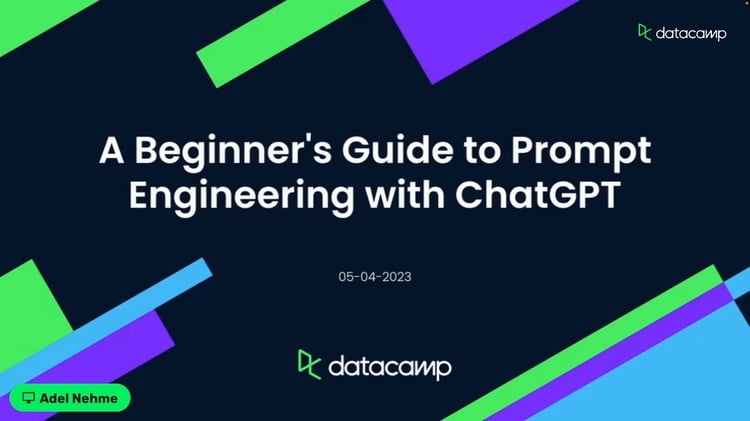Course
I wonder how many people try ChatGPT once, get disappointed, and give up. I remember a colleague of mine asked it to "help with data analysis" last week. She got generic advice about cleaning datasets and checking for outliers. Technically correct, but completely useless for her actual problem. I helped her try something different: "Analyze this sales dataset for seasonal trends and suggest which product categories show declining performance." That time, she got real insights in seconds.
The difference wasn't the AI. It was the prompt. A prompt is just the instruction you give ChatGPT, and it controls everything about what you get back. It’s true that vague prompts produce vague answers and specific prompts produce useful ones. But there's more to it than that. I'll walk you through the
In this article, I'll share what I've learned about writing effective ChatGPT prompts and I’ll show specific techniques that actually work. You'll see practical examples for writing, coding, data analysis, business tasks, and learning, plus advanced techniques for handling complex workflows and automation.
The Basics of ChatGPT Prompting
A prompt is whatever you type into ChatGPT. It could be a question ("What is gradient descent?"), an instruction ("Summarize this paragraph"), or something with more context ("You are a SQL instructor. Explain joins to beginners").
The difference between simple and structured prompts is dramatic. Look at these two:
Simple prompt:
Write about machine learningStructured prompt:
Write a 150-word explanation of supervised learning for business analysts with no technical background. Use an analogy involving customer data.The first gives ChatGPT almost nothing to work with. The second specifies audience, length, and approach. You'll get completely different results.
Prompt engineering is the skill of designing effective inputs for AI. It's not programming. It's communication. You're learning how to give clear directions based on how ChatGPT processes language.
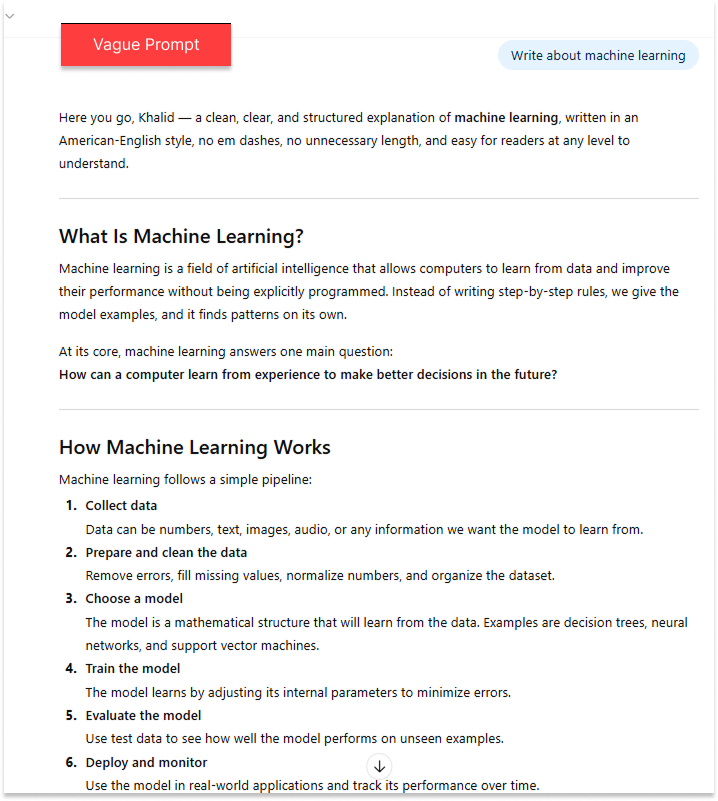
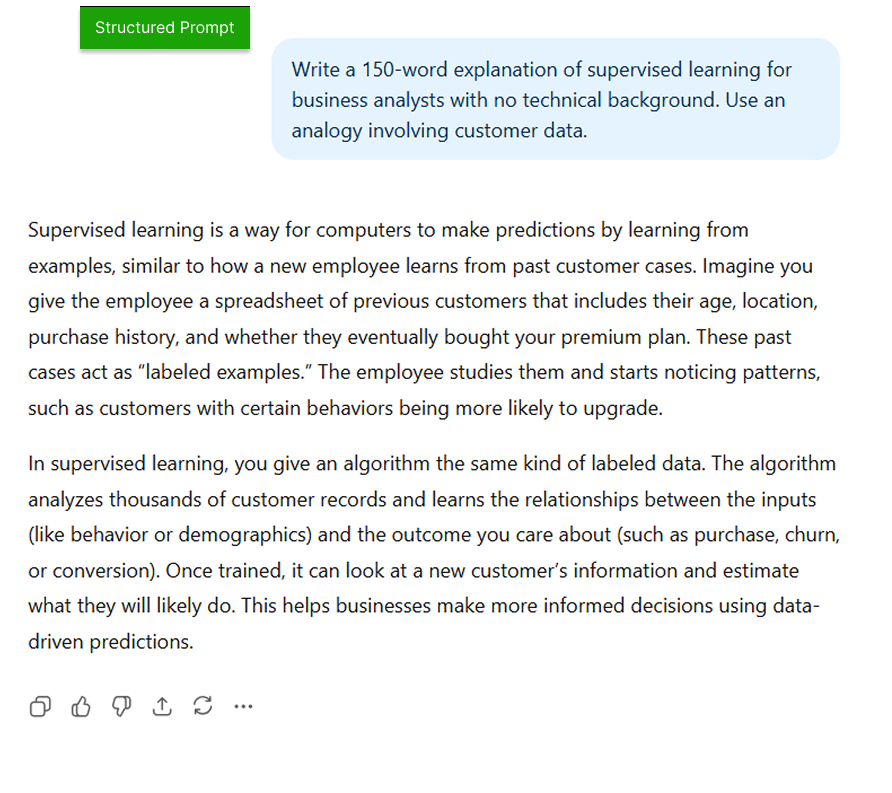
I stopped treating prompts like search queries and started treating them like instructions. Once I made that shift, my results improved dramatically.
How ChatGPT Understands Prompts
ChatGPT interprets your instructions based on context, role, tone, and structure. It doesn't truly "understand" like humans do. It predicts what response makes sense based on patterns it learned during training. That's why clarity matters so much.
Three key factors affect how ChatGPT reads your prompt:
- Clarity: Vague language produces inconsistent results. "Explain Python" could mean a dozen different things. "Explain how Python's list comprehension syntax works, with three examples" is clear and specific.
- Specificity: Generic prompts get generic answers. Ask "How do I analyze data?" and ChatGPT has to guess what you know, what tools you use, and what you're trying to accomplish. Ask "Show me how to identify outliers in a Pandas DataFrame using the IQR method" and you get something immediately useful.
- Structure: Organized prompts work better. If you break complex requests into numbered steps or bullet points, ChatGPT follows along more easily.
Assigning a role changes how ChatGPT responds. Write "You are a financial analyst" and it adjusts its language and depth automatically. This works because the model has seen countless examples of how financial analysts communicate.
Tone matters, too. Ask for a "formal business summary" versus a "casual explanation for a friend" and you'll get very different styles.
Note: If you use the ChatGPT API, you can control randomness with the temperature setting (0 = consistent, 1 = creative) and set system messages that apply to the entire conversation. For most users working with the web interface, the key is being specific in your prompts.
ChatGPT Prompt Examples by Category
I've organized these examples by category. Each section explains what makes prompts work in that domain, then gives you examples you can copy and adapt to your own work.
Writing prompts
What makes them work:
- Specify audience, tone, and format
- Set word count or structure limits
- Define the purpose clearly
Example 1: Blog introduction
Write a 100-word blog introduction explaining why SQL remains essential for data analysis despite the rise of Python and R. Target audience: data analysts considering which skills to prioritize.Example 2: Professional email
Draft a 150-word email to a client explaining a project delay. Tone: professional but empathetic. Include a revised timeline and one proactive solution to minimize impact.Example 3: Social media content
Write three LinkedIn post variations (under 200 characters each) announcing a new data visualization course. Emphasize practical skills over theory. Use a conversational, encouraging tone.Example 4: Technical documentation
Rewrite this API error message for non-technical users: "Authentication token expired. Error 401." Make it clear what happened and what action to take.Example 5: Creative writing
Write a 200-word product description for noise-canceling headphones. Target remote workers. Focus on productivity benefits, not technical specs. Conversational tone.See the pattern? Each prompt says who's reading, why, and what format you want. No guesswork. You get usable first drafts.
Coding prompts
What makes them work:
- Specify programming language and task type
- Include error messages or code context
- Ask for reasoning, not just output
Example 1: Code generation
Write a Python function that takes a list of dictionaries and returns a new list containing only items where the 'status' key equals 'active'. Include error handling for missing keys.Example 2: Debugging
This Python function is supposed to calculate the median of a list, but it fails on even-length lists. Identify the bug and provide a corrected version:
def median(numbers):
sorted_nums = sorted(numbers)
mid = len(sorted_nums) // 2
return sorted_nums[mid]Example 3: Code explanation
Explain what this SQL query does, identify any performance concerns, and suggest an optimized version:
SELECT * FROM orders WHERE customer_id IN (SELECT id FROM customers WHERE region = 'West')Example 4: Refactoring
Refactor this JavaScript code to use async/await instead of promise chaining. Maintain the same error handling logic:
[paste code here]Example 5: Edge case identification
Review this Python function for edge cases it doesn't handle. List each edge case and suggest how to fix it:
def divide_list(numbers, divisor):
return [n / divisor for n in numbers]Tip: For debugging, add "explain your reasoning at each step" to catch logical errors that simple code generation misses.
Data analysis prompts
What makes them work:
- Describe your dataset structure
- Ask for interpretation and reasoning
- Request visualization recommendations
Example 1: Exploratory analysis
I have a sales dataset with columns: date, product_category, revenue, region. Suggest five exploratory questions I should investigate first, and explain why each matters for business decisions.Example 2: Trend identification
This dataset shows monthly website traffic for 18 months: [paste data]. Identify three meaningful trends and explain what might be causing each one.Example 3: Visualization recommendations
I need to present quarterly revenue by product line (5 categories) to executives. Suggest the best chart type and explain why it's more effective than alternatives.Example 4: Statistical approach
I want to test whether a new checkout process increased conversion rates. I have before/after data for 1,000 users. What statistical test should I use and why? What assumptions do I need to verify first?Example 5: Data quality assessment
Review this customer dataset summary: 10,000 rows, 15% missing email addresses, age ranges from 18-120, some negative purchase amounts. Prioritize the three most critical data quality issues and suggest fixes.Business prompts
What makes them work:
- Assign a role with business context
- Request structured, actionable output
- Set clear constraints and scenarios
Example 1: Market analysis
You are a market analyst. Summarize the top three risks for a U.S.-based SaaS company expanding to the European market. For each risk, provide one specific mitigation strategy. Keep the response under 200 words.Example 2: Competitive positioning
Compare three project management tools - Asana, Monday.com, and Trello - for a 50-person marketing team. Focus on collaboration features and pricing. Present findings as a decision matrix.Example 3: Business case development
Draft a business case for implementing automated customer support chatbots. Include expected cost savings, implementation timeline, and two potential risks. Target audience: CFO and operations director.Example 4: Meeting preparation
I'm presenting Q3 results to the board. Revenue is up 12% but customer acquisition cost increased 18%. Prepare three talking points that acknowledge the CAC increase while emphasizing overall growth trajectory.Example 5: Process improvement
Our sales team spends 10 hours weekly manually updating CRM records. Suggest three automation solutions, ranked by implementation difficulty and potential time savings.Learning and teaching prompts
What makes them work:
- Specify the learner's current knowledge level
- Request analogies and concrete examples
- Ask for step-by-step explanations
Example 1: Concept explanation with analogy
Explain gradient descent to someone learning machine learning for the first time. Use a hiking analogy. Keep it under 150 words.Example 2: Beginner-friendly breakdown
I'm learning Python and don't understand decorators. Explain what they do, why they're useful, and show one simple example. Assume I understand functions but not advanced concepts.Example 3: Quiz generation
Create five multiple-choice questions testing understanding of SQL joins. Include one question each for: inner join, left join, right join, full outer join, and cross join. Provide explanations for correct answers.Example 4: Step-by-step tutorial
Teach me how to create a pivot table in Excel. I've never used them before. Break it into numbered steps with one clear action per step. Use a sample sales dataset as the example.Example 5: Concept comparison
Explain the difference between supervised and unsupervised learning as if teaching a business analyst with no machine learning background. Use real-world business examples for each.How to Write Better ChatGPT Prompts
Better prompts balance clarity with context. Here are proven techniques that improve results:
Zero-shot prompting
Zero-shot prompting just means asking directly without examples. It works for simple stuff:
Summarize this paragraph in one sentence: [paste text]One-shot prompting
One-shot prompting gives one example to show the tone or format you want:
Convert these technical terms to plain language. Example: "API" becomes "a way for software programs to communicate with each other."
Now convert: "OAuth authentication"Few-shot prompting
Few-shot prompting gives multiple examples to teach a pattern:
Convert these product names to URL-friendly slugs:
"Premium Wireless Headphones" → "premium-wireless-headphones"
"4K Ultra HD Monitor" → "4k-ultra-hd-monitor"
Now convert: "Ergonomic Standing Desk Pro"
Tip: Save your best few-shot prompts. Keep a document of templates for code reviews, data analysis, and report writing that you reuse constantly.
Chain-of-thought prompting
Chain-of-thought prompting asks ChatGPT to reason step-by-step:
A store sells notebooks for $3 each. If you buy 5 or more, you get 20% off the total. How much do 7 notebooks cost? Think step by step.
Role prompting
Role prompting sets expertise and communication style:
You are a SQL instructor teaching beginners. Explain what a foreign key is and why it matters in 100 words or less. Use a real-world analogy.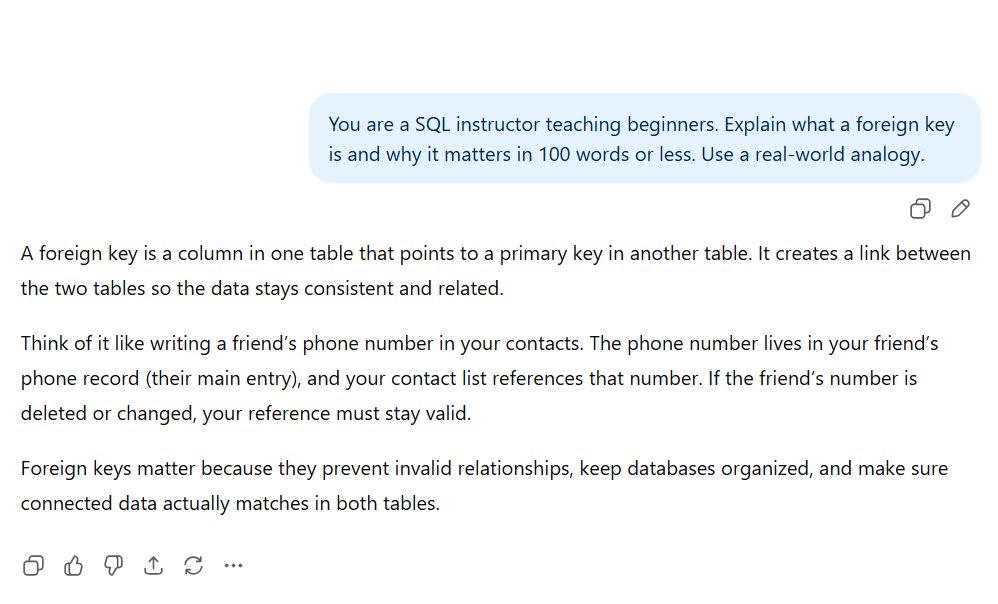
Constraints and formatting keep responses focused:
List three advantages of cloud computing. Requirements:
Bullet points
One sentence per point
Focus on cost and scalability
Under 100 words totalI rarely get it right on the first try. My workflow: start simple, check the output, then add 2-3 specific details for the next attempt. Usually works by the second or third try.
Advanced Prompting Techniques
I'll walk you through techniques that push ChatGPT's reasoning, consistency, and automation capabilities for complex tasks.
Self-consistency and reflection prompts
Ask ChatGPT to generate multiple solutions and compare them:
Generate three approaches to reducing customer churn for a SaaS company, each in 2 sentences. Then compare them in 3 sentences and recommend the best one.
Reflection prompts catch errors:
Review your previous answer for accuracy, clarity, and completeness. Identify any gaps or potential improvements.Meta-prompting
Ask ChatGPT to design prompts for you:
I need to summarize academic papers. Generate three reusable prompt templates: one for methodology, one for key findings, and one for limitations. Keep each template under 20 words.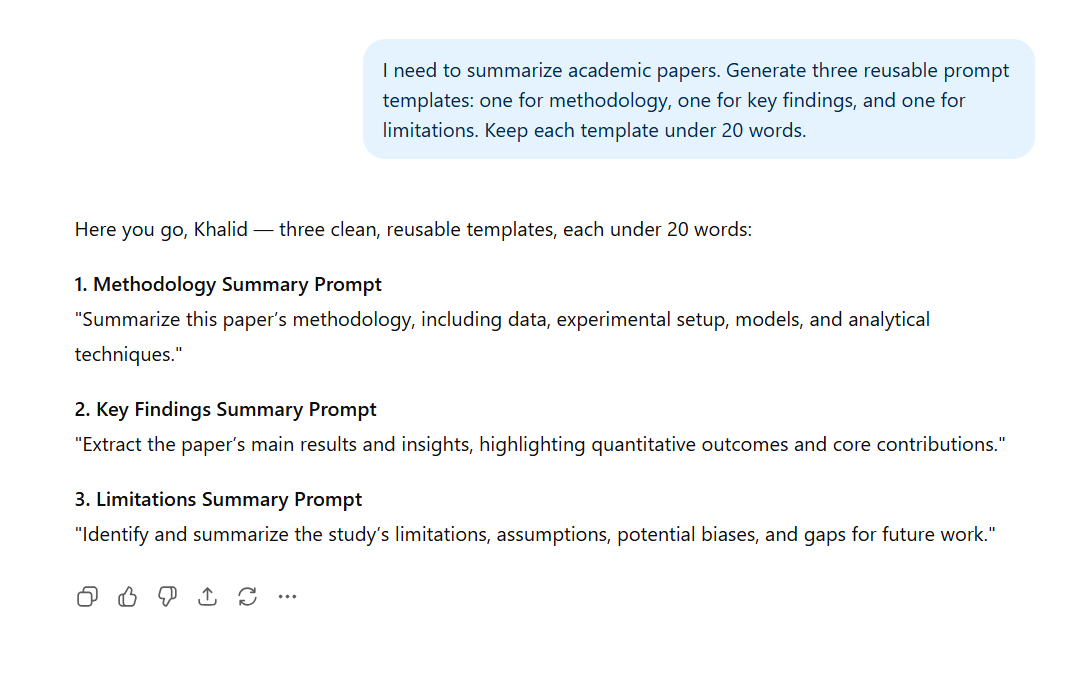
Context-window management
Keep long conversations focused by reminding ChatGPT of your goals:
Reminder: We're designing a data pipeline for real-time analytics. All suggestions should prioritize low latency over storage efficiency.
Now, how should we handle schema changes?In long conversations, I restate my main objective every few exchanges. It keeps ChatGPT aligned with what I'm actually trying to accomplish.
Multi-turn and modular prompting
Break big tasks into sequential steps:
Example workflow for writing a technical article:
Prompt 1:
Generate an outline for a 2,000-word article on API rate limiting. Include 5 main sections with 2-3 subsections each.Prompt 2:
Using the outline you just created, write a 200-word introduction that explains why rate limiting matters for API developers.Prompt 3:
Now expand the "Implementation Strategies" section. Include code examples in Python.Check and adjust at each step instead of generating everything at once. For automation, developers can script these sequences using the OpenAI API.
Role and perspective stacking
Combine multiple roles for balanced answers:
You are both a data scientist and a project manager. Explain how to prioritize machine learning projects. Address both technical feasibility and business impact.I've found that combining roles like "data scientist and business analyst" gives me balanced answers when I need both technical depth and practical application.
Evaluation and self-critique prompts
Have ChatGPT rate its own output:
[After receiving a response]
Rate your previous answer on these dimensions:
- Clarity (1-10)
- Accuracy (1-10)
- Completeness (1-10)
For any score below 8, explain what's missing and provide an improved version.Prompt templates and reusability
Build reusable templates for frequent tasks:
Template for dataset analysis:
Analyze this [DATASET TYPE] dataset with [NUMBER] rows and [NUMBER] columns.
Provide:
1. Overview: Key characteristics and data types
2. Trends: Three meaningful patterns
3. Outliers: Unusual values or anomalies
4. Visualizations: Suggest three charts with rationale
Dataset: [PASTE DATA OR DESCRIPTION]Common Mistakes and How to Fix Them
Mistake 1: Vague or overly broad prompts
Bad: Tell me about Python
Why it fails: ChatGPT has to guess what you want. You'll get generic content.
Fixed:
Explain how Python's list comprehension syntax works. Include three examples: filtering a list, transforming values, and nested comprehensions.Mistake 2: Asking multiple unrelated questions at once
Bad: Explain machine learning, recommend a Python course, and help me debug this code
Why it fails: ChatGPT splits attention across three tasks. Each answer will be shallow.
Fixed: Break into separate prompts, one task each.
Mistake 3: Ignoring model limitations
Bad: What were Apple's exact revenue figures for Q3 2025?
Why it fails: ChatGPT can't access real-time data and might make up plausible-sounding numbers.
Fixed:
Explain how to interpret a company's quarterly revenue report. What metrics should I focus on beyond top-line revenue?Mistake 4: No constraints or format specification
Bad: Summarize this article: [paste long article]
Why it fails: No guidance on length, focus, or audience.
Fixed:
Summarize this article in three bullet points. Focus on actionable takeaways for data analysts. Maximum 150 words total.Mistake 5: Assuming ChatGPT remembers context from way back
Bad: Use the approach we discussed earlier (after 20 exchanges)
Fixed:
Use the Python pandas approach we discussed for handling missing values (forward fill method). Apply it to this new dataset: [paste data]Conclusion
Good ChatGPT prompts come down to clear communication. The difference between okay and great results is specificity: say who your audience is, set limits, and be explicit about what you want.
I started with the basics - role assignment, few-shot examples, chain-of-thought reasoning - and adapted them to my work. I paid attention to which prompts worked and which didn't. That's how I got better at this.
These techniques work across different fields because they match how ChatGPT processes language. Whether you're coding, analyzing data, or writing business docs, the same rules apply: be clear, be specific, and iterate based on results.
To build your AI and data skills, check out our Introduction to ChatGPT course and AI Fundamentals track. For hands-on practice with prompts in data work, see Working with the OpenAI API
Data Engineer with Python and Azure cloud technologies expertise, specializing in building scalable data pipelines and ETL processes. Currently pursuing a B.S. in Computer Science at Tanta University. Certified DataCamp Data Engineer with demonstrated experience in data management and programming. Former Microsoft Data Engineer Intern at Digital Egypt Pioneers Initiative and Microsoft Beta Student Ambassador leading technical workshops and organizing hackathons.
ChatGPT Prompts FAQs
What makes a good ChatGPT prompt?
A good prompt is specific, provides context, and states clear expectations. It defines the audience, format, and constraints. Instead of "explain machine learning," try "explain supervised learning to a business analyst using a customer data analogy, in under 150 words."
How long should a ChatGPT prompt be?
Length matters less than clarity. A 10-word prompt can be great if it's specific. A 200-word prompt can be awful if it's unfocused. Give enough context for ChatGPT to understand what you want, but skip unnecessary details. Most good prompts are 20-100 words.
Should I use technical jargon in my prompts?
Use jargon when it adds precision, but define your terms if the context matters. "Use the IQR method to identify outliers" is clear for data analysts. For general audiences, "identify unusual values in this dataset" works better. Match your language to the expertise level you want in the response.
Can ChatGPT remember context from earlier in a conversation?
Yes, but with limits. ChatGPT keeps context within a conversation, but long exchanges can get messy. For important context from way back, say it again explicitly instead of assuming it remembers. Use phrases like "using the approach we discussed for [specific topic]" to remind it.
How do I get ChatGPT to stop giving generic answers?
Add limits and be specific. Generic prompts get generic answers. Say who your audience is, what you're doing, what format you want, and any limits. Ask for examples, analogies, or step-by-step reasoning. Role assignment ("You are a data scientist...") also helps get responses that match what you need.


